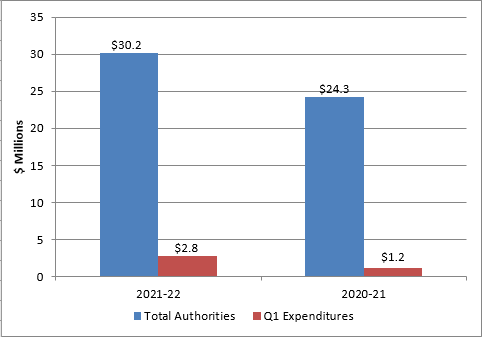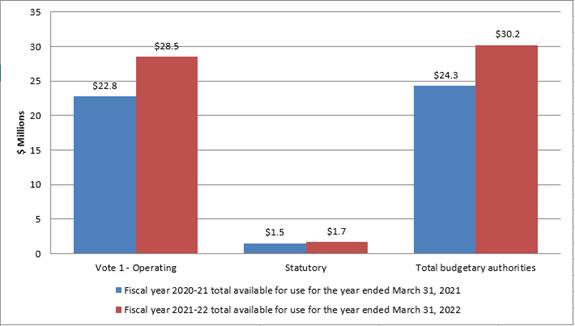Date of Publishing:
Introduction
This quarterly report has been prepared by management as required by section 65.1 of the Financial Administration Act and in the form and manner prescribed by the Directive on Accounting Standards, GC 4400 Departmental Quarterly Financial Report. This quarterly financial report should be read in conjunction with the 2021-22 Main Estimates.
A summary description of the National Security and Intelligence Review Agency Secretariat (NSIRA) program activities can be found in Part II of the Main Estimates. For information on the mandate of NSIRA, please visit its website at https://nsira-ossnr.gc.ca.
This quarterly report has not been subject to an external audit or review.
Mandate
The NSIRA is an independent external review body, which reports to Parliament. NSIRA was established in July of 2019 and is responsible to conduct reviews of the Government of Canada national security and intelligence activities to ensure that they are lawful, reasonable and necessary. NSIRA also hears public complaints regarding key national security agencies and activities. NSIRA replaces the Security Intelligence Review Committee (SIRC), which reviewed CSIS (Canadian Security Intelligence Service) activities as well as those related to the revocation or denial of security clearances. It also hears complaints regarding the Communication Security Establishment (CSE), as well as national security-related complaints regarding the RCMP.
Basis of presentation
This quarterly report has been prepared by management using an expenditure basis of accounting. The accompanying Statement of Authorities includes the department’s spending authorities granted by Parliament and those used by the department, consistent with the 2021-22 Main Estimates. This quarterly report has been prepared using a special purpose financial reporting framework (cash basis) designed to meet financial information needs with respect to the use of spending authorities.
The authority of Parliament is required before moneys can be spent by the Government. Approvals are given in the form of annually approved limits through appropriation acts or through legislation in the form of statutory spending authority for specific purposes.
Highlights of the fiscal quarter and fiscal year-to-date results
This section highlights the significant items that contributed to the net increase or decrease in authorities available for the year and actual expenditures for the quarter ended June 30, 2021.
NSIRA spent approximately 9% of its authorities by the end of the first quarter, compared to 5% in the same quarter of 2020-21 (see graph 1 below).
Graph 1: Comparison of total authorities and total net budgetary expenditures, Q1 2021–22 and Q1 2020–21

Text version of Figure 1
| 2021-22 | 2020-21 | |
|---|---|---|
| Total Authorities | $30.2 | $24.3 |
| Q1 Expenditures | $2.8 | $1.2 |
Significant changes to authorities
As per graph 2 below as at June 30, 2021, NSIRA had authorities available for use of $30.2 million in 2021-22 compared to $24.3 million as of June 30, 2020, for a net increase of $5.9 million or 24.3%.
Graph 2: Variance in authorities as at June 30, 2021

Text version of Figure 2
| Fiscal year 2020-21 total available for use for the year ended March 31, 2021 | Fiscal year 2021-22 total available for use for the year ended March 31, 2022 | |
|---|---|---|
| Vote 1 – Operating | $22.8 | $28.5 |
| Statutory | $1.5 | $1.7 |
| Total budgetary authorities | $24.3 | $30.2 |
The authorities’ increase of $5.9 million is mostly explained by the ramp-up of approved funding for the mandate of NSIRA and the approval of a funding reprofile into fiscal year 2021-22 for accommodation and infrastructure projects.
Significant changes to quarter expenditures
The first quarter expenditures totaled $2.7M for an increase of $1.5M when compared to $1.2M spent during the same period in 2020-21. Table 1 below presents budgetary expenditures by standard object.
Table 1
(in thousands of dollars)
| Material Variances to Expenditures by Standard Object | YTD Expenditures as of June 30, 2021 | YTD Expenditures as of June 30, 2020 | Variance $ | Variance % |
|---|---|---|---|---|
| Personnel | 2,312 | 1,111 | 1,201 | 108% |
| Transportation and communications | 13 | 7 | 6 | 86% |
| Information | 2 | 50 | (48) | (96%) |
| Professional and special services | 196 | 68 | 128 | 188% |
| Repair and maintenance | 8 | 0 | 8 | 100% |
| Utilities, materials and supplies | 3 | 9 | (6) | (67%) |
| Acquisition of machinery and equipment | 216 | 0 | 216 | 100% |
| Other subsidies and payment | 12 | 0 | 12 | 100% |
| Total gross budgetary expenditures | 2,762 | 1,246 | 1,516 | 122% |
Personnel
The increase of $1.2M relates to additional staffing to support NSIRA’s departmental mandate as well as higher statutory expenditures in 2021-22.
Transportation and communications
The increase of $6K is mainly explained by the relocation of an employee.
Information
The decrease of $48K is explained by lower expenditures for electronic subscriptions.
Professional and special services
The increase of $128K is mainly due to contracts in management consulting, including procurement and business advisory services.
Repair and maintenance
The increase of $8K is explained by office accommodation fit-up costs.
Utilities, Materials and Supplies
The decrease of $6K is mainly explained by lower expenditures for cleaning supplies and personal protective equipment for the pandemic over the previous year.
Acquisition of machinery and equipment
The increase of $216K is mainly explained by the acquisitions of informatics equipment and related cyber security products.
Other Subsidies and payments
The increase of $12K due to multiple payroll system overpayments processed in the first quarter of 2021-22.
Risks and uncertainties
The COVID-19 pandemic had a significant impact on the ability of NSIRA to grow its organization in a way that is commensurate with its new mandate. The physical distancing requirements decreased the ability of staff to concurrently work with departments and agencies subject to reviews. In light of that, NSIRA revised its Review Plan and has advanced the introduction of a new approach to the review of complaints.
The ability to hire a sufficient number of qualified personnel within relevant timelines remains a short- and medium-term risk for NSIRA, particularly given the specialized knowledge and skillset required for many positions. This is further compounded by the requirement for candidates to obtain a Top Secret security clearance, which can incur significant delays, especially during the pandemic.
While NSIRA has been able to secure temporary space to address its immediate space requirements, significant delays have been incurred for the fit-up of this space due to the pandemic. NSIRA is working closely with Public Services and Procurement Canada and Shared Services Canada to expedite the office expansion plans.
The ability of NSIRA to access the information it needs to do its work and speak to the relevant stakeholders to understand policies, operations and ongoing issues is closely tied to the reviewed departments’ and agencies’ capacity to respond to the demands of NSIRA. The pandemic impacts including the ability to conduct classified work at the workplace combined with existing resource constraints of the reviewed departments and agencies continue to delay the conduct of reviews.
NSIRA is closely monitoring pay transactions to identify and address over and under payments in a timely manner and continues to apply ongoing mitigating controls, which were implemented in 2016.
Mitigation measures for the risks outlined above have been identified and are factored into NSIRA’s approach to the conduct of its mandate.
Significant changes in relation to operations, personnel and programs
The pandemic forced changes in the way NSIRA conducts operations. The requirement for physical distancing and the existing challenge with respect to the high security zone accommodation has led NSIRA to authorize staff to work with non-sensitive files from home.
In late March 2021, NSIRA was victim of a cyber attack on its public network. The attack did not affect its classified networks. That attack has led NSIRA to change its Information Technology (IT) operating model and NSIRA has since then been using the Privy Council Office IT infrastructure for the conduct of it’s unclassified and up to protected B activities.
The Honourable Marie Deschamps has also recently been named interim Chair for NSIRA.
There have been no changes to the NSIRA Program.
Approved by senior officials:
John Davies
Deputy Head
Pierre Souligny
Senior Director, Corporate Services, Chief Financial Officer
Appendix
Statement of authorities (Unaudited)
(in thousands of dollars)
| Fiscal year 2021–22 | Fiscal year 2020–21 | |||||
|---|---|---|---|---|---|---|
| Total available for use for the year ending March 31, 2022 (note 1) | Used during the quarter ended June 30, 2021 | Year to date used at quarter-end | Total available for use for the year ending March 31, 2021 (note 1) | Used during the quarter ended June 30, 2020 | Year to date used at quarter-end | |
| Vote 1 – Net operating expenditures | 28,490 | 2,336 | 2,336 | 22,801 | 875 | 875 |
| Budgetary statutory authorities | ||||||
| Contributions to employee benefit plans | 1,705 | 426 | 426 | 1,484 | 371 | 371 |
| Total budgetary authorities (note 2) | 30,195 | 2,762 | 2,762 | 24,285 | 1,246 | 1,246 |
Note 1: Includes only authorities available for use and granted by Parliament as at quarter-end.
Departmental budgetary expenditures by standard object (unaudited)
(in thousands of dollars)
| Fiscal year 2021–22 | Fiscal year 2020–21 | |||||
|---|---|---|---|---|---|---|
| Planned expenditures for the year ending March 31, 2022 (note 1) | Expended during the quarter ended June 30, 2021 | Year to date used at quarter-end | Planned expenditures for the year ending March 31, 2021 | Expended during the quarter ended June 30, 2020 | Year to date used at quarter-end | |
| Expenditures | ||||||
| Personnel | 13,222 | 2,312 | 2,312 | 11,510 | 1,111 | 1,111 |
| Transportation and communications | 673 | 13 | 13 | 1,162 | 7 | 7 |
| Information | 375 | 2 | 2 | 364 | 50 | 50 |
| Professional and special services | 5,904 | 196 | 196 | 3,250 | 68 | 68 |
| Rentals | 188 | 0 | 0 | 237 | 0 | 0 |
| Repair and maintenance | 8,737 | 8 | 8 | 7,134 | 0 | 0 |
| Utilities, materials and supplies | 103 | 3 | 3 | 173 | 9 | 9 |
| Acquisition of machinery and equipment | 991 | 216 | 216 | 393 | 0 | 0 |
| Other subsidies and payments | 0 | 12 | 12 | 63 | 0 | 0 |
| Total gross budgetary expenditures (note 2) |
30,195 | 2,762 | 2,762 | 24,285 | 1,246 | 1,246 |
Note 1: Includes only authorities available for use and granted by Parliament as at quarter-end.
Note 2: Details may not sum to totals due to rounding.
